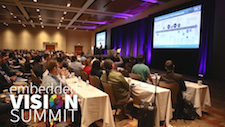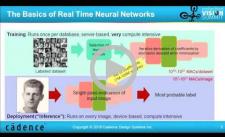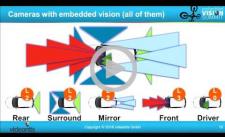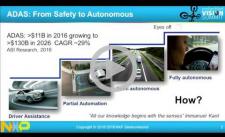| LETTER FROM THE EDITOR |
|
Dear Colleague,
This year's Embedded Vision Summit, which took place last week, was the best yet; more than 1,000 attendees, more than 90 speakers across five presentation tracks, and more than 50 exhibitors demonstrating more than 100 vision technologies and products. A downloadable slide set of the presentations from the Summit is now available on the Embedded Vision Alliance website. Demo and presentation videos from the event will follow in the coming weeks. For timely notification of the publication of this and other new website content, subscribe to the Alliance's RSS feed and Facebook, Google+, LinkedIn company and group, and Twitter social media channels. And mark your calendar for next year's Summit, scheduled for May 22-24, 2018, again at the Santa Clara (California) Convention Center!
Brian Dipert
Editor-In-Chief, Embedded Vision Alliance
|
| DEEP LEARNING FOR VISION |
|
The Road Ahead for Neural Networks: Five Likely Surprises
Cognitive computing is finally getting real! It has passed through the phases of obscurity and curiosity and is surviving the current phase of breathless hype. It’s coming to market in real products and promises to radically expand our ability to extract value from video, images, speech and big data. This talk from Cognite Ventures' Dr. Chris Rowen examines the fundamental capabilities and limitations of neural network computing, especially for real-time and embedded systems, and paints a picture of how it will likely evolve over the next decade. In particular, it explores the impacts of neural networks on industry and forecasts a series of developments, including unexpected changes in business models for data and training, in distribution of neural networks between the cloud and edge devices, in new types of systems hardware, and in novel software. This intriguing shift in the computing landscape will create a new crop of winners and may leave others behind.
TensorFlow: Enabling Mobile and Embedded Machine Intelligence
Pete Warden, Research Engineer at Google, delivers a presentation on the company's TensorFlow deep learning framework. Following a brief overview of the advances in deep learning and AI over the last few years, Warden discusses how Google uses TensorFlow to deploy those advances in products on mobile and embedded devices. Key examples are Google Translate, Google Photos, and OK Google. He then discusses why the company open-sourced the framework and talks about TensorFlow's focus on supporting low-power applications using approaches such as specialized hardware, shrinking models and code.
|
| ADAS AND AUTONOMOUS VEHICLES |
|
Computer Vision in Cars: Status, Challenges, and Trends
Just as horse carriages were replaced by cars in the 1920s, human operators in our cars will be replaced by electronics in the 2020s. The benefits are tremendous: self-driving cars save lives, save time and save cost. For car manufacturers, this will be a gradual change. With each new model year, they’re adopting increasingly sophisticated advanced driver assistance systems (ADAS) that aid the driver, instead of taking full control. These systems use cameras and computer vision techniques to understand the vehicle’s surroundings. Besides detecting pedestrians, vehicles, lanes, signs, and obstacles, these systems must be aware of where these objects are, and where they’re going. In this talk, Marco Jacobs, Vice President of Marketing at videantis, provides an overview of the state of ADAS today and gives a glimpse into the future. He highlights technology trends, challenges, and lessons learned, with a focus on the crucial role that computer vision plays in these systems.
Sensing Technologies for the Autonomous Vehicle
Autonomous vehicles will necessarily utilize a range of sensing technologies to see and react to their surroundings. We are witnessing dramatic advances not just for embedded vision, but also in complementary technologies like radar and LiDAR. Each of these sensing technologies provides unique capabilities for giving a vehicle a complete view of its surroundings. This presentation from Tom Wilson, ADAS Product Line Manager at NXP Semiconductors, compares vision-based sensing with complementary sensing technologies, explores key trends in sensors for autonomous vehicles, and analyses challenges and opportunities in fusing the output of multiple sensor technologies to enable robust perception and mapping for autonomous vehicles.
|
| UPCOMING INDUSTRY EVENTS |
|
AutoSens Conference: May 22-25, 2017, Detroit, Michigan
Xilinx Webinar Series – Caffe to Zynq: State-of-the-Art Machine Learning Inference Performance in Less Than 5 Watts: May 24, 2017, 10:00 am PT
Intel Webinar – Develop Smart Computer Vision Solutions Faster: June 14, 2017, 10:00 am PT
Sensors Expo & Conference: June 27-29, 2017, San Jose, California
TensorFlow Training Class: July 13, 2017, Santa Clara, California
Xilinx Webinar Series – OpenCV on Zynq: Accelerating 4k60 Dense Optical Flow and Stereo Vision: July 12, 2017, 10:00 am PT
TensorFlow Training Class: September 7, 2017, Hamburg, Germany
More Events
|
| FEATURED COMMUNITY DISCUSSIONS |
|
Multiple Positions @ Density: ToF, 3D Depth, Embedded Computer Vision
More Community Discussions
|
| FEATURED NEWS |
|
Allied Vision Brings Machine Vision Performance to the Embedded World with Innovative Camera Platform
NVIDIA Paves Path to AI Cities with Metropolis Edge-to-Cloud Platform for Video Analytics
Cadence Unveils Industry’s First Neural Network DSP IP for Automotive, Surveillance, Drone and Mobile Markets
VeriSilicon’s Vivante VIP8000 Neural Network Processor IP Delivers Over 3 Tera MACs Per Second
Au-Zone Introduces DeepView, a Machine Learning Toolkit and Run-time Inference Engine for Embedded Processors
More News
|







